From the sea to the sky (and back): Going to the limit in Eilat
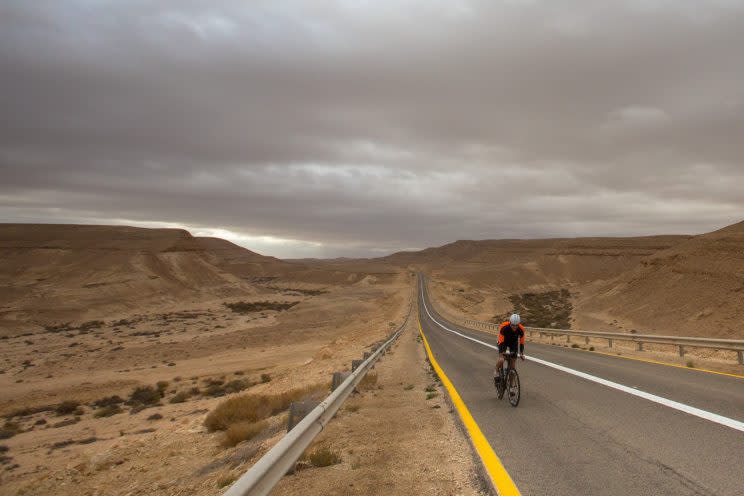
In Israel, the saying goes that you pray in Jerusalem, party in Tel Aviv and study in Haifa. That axiom doesn’t entirely slide off the tongue but does speak to the three pillars that serve as a kind of foundation for the country. Left unmentioned is Eilat, which is strange because if there was ever a place that epitomized this stunning yet precariously placed land, it’s this tiny seaside resort.
Eilat is the last stop in Israel, the most southern point on the map. It’s where everything comes to a head. If you stand on the main promenade, amidst the dance bars and the boutiques, the Jordanian border is barely a kilometre away. On the other side, just a little up the street is Egypt. And over there, twinkling along the Gulf of Aqaba, are the lights of Saudi Arabia.
Yet to be here is to stand on one of the most beautiful beaches in the country. Where you can bask in the surrounding mountain views or slip into the Red Sea’s translucent waters. The scene could hardly be more exotic.
I’m in Eilat for the Israman Garmin, an Ironman-distance triathlon that starts with a swim in the Red Sea, then has us cycling up, up, up above the Arava Valley, before winding us back down on foot into the town. It will be an all-day effort and no one, least of all the race directors, is offering any illusion of what’s in store. Rather than stressing how scenic or speedy the course will be, which is typically what’s said in these settings, the pre-race instructions focus almost solely on the bitterly cold temperatures and brutal crosswinds that await us in the mountains. There are also a few asides about the bomb shelters located along the way, and a mention of the buses that will up scoop us up “if something unexpected happens.” The crowd assembled today, almost all of whom are Israeli, seem entirely nonplussed by this last bit.
Truth be told, I’m also far more worried about perils that I know are assured; like the fact that it’s going to be chilly in the water, and downright frigid on the bike. Of course, these are all problems that could easily have been prevented if I had packed properly, which I didn’t, opting to travel as unburdened as possible. Well, that and I thought if anything, Eilat would be too hot.
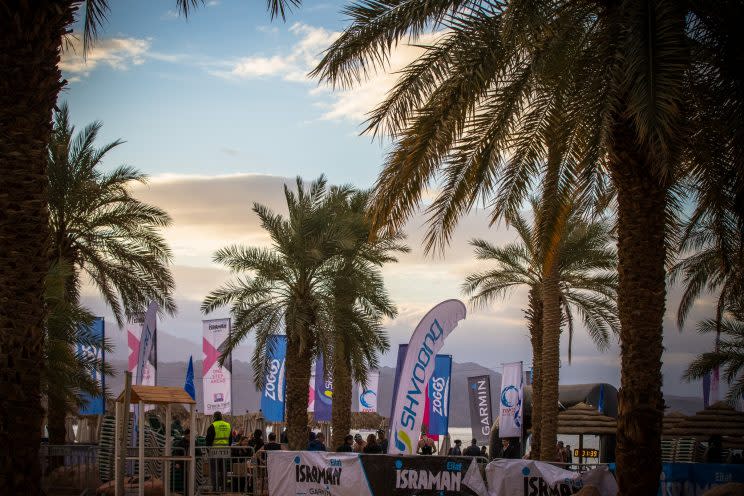
Lots of sunshine and little sharp teeth
Indeed, the resort is famed for its warmth, ferociously so. In the summer, highs of 42 °C are commonplace. Even in the winter, Eilat seldom dips below 16 °C during the day. The combination of splendid weather and sparkling beaches is the reason it’s become such a beloved winter getaway for Israelis escaping the considerably chillier conditions of Jerusalem, and to a lesser extent, Tel Aviv, 350km to the north.
A key part of Eilat’s appeal is its massive coral reef that features all manner of marine life, including sharks, dolphins and barracudas. The reef is the most northern of its kind in the world.
To that end, the water here is either invitingly warm or bracingly cool year-round, depending on your perspective. (It would seem that most Israelis subscribe to that second view, given that almost every competitor has shown up in a wetsuit.)
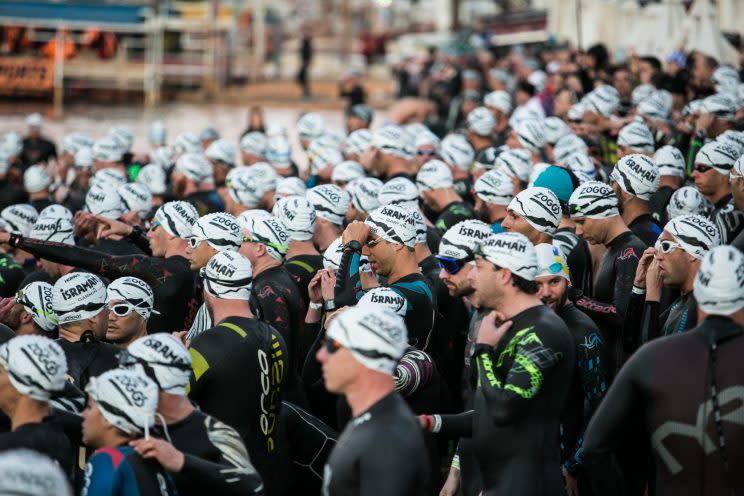
There are actually two races this morning, the full and the half Ironman distance. The full involves a 3.8km swim, an 180km cycle and then finally, a 42.2km run. The half is…. well, half of each. As I’m a long way from home, with slightly nebulous health insurance coverage, I decide that the half will be far enough for me.
Two km of salt, plus water
This morning we’ll start on Eilat’s central beach, in front of the wall of hotels, and swim nearly a kilometre out into the gulf. We’ll take two quick lefts and head back. Our ‘corral’ will start at 7:35 am. It’s now just after 7 am, the sun has peeked over the Jordanian mountains (just barely), but the temperature has yet to rise above 6 °C. We’re packed into the pre-race area like seals. Some competitors have dipped into the water to do a few practice strokes, but as I am only one of two here wearing a bathing suit, I’m staying dry, and in the huddle.
Then we’re off. Like most triathlons, the first 10 minutes is an unholy tangle of arms, elbows and inadvertent kicks to the head. It begins to sink in that a nation where virtually everyone serves in the army is not necessarily the place to pursue a contact sport. Meekness is not a defining characteristic here. That said, this morning’s mayhem is not much fiercer than anything you’d experience in Canada.
However one mighty difference here is the water. It’s crystal clear, but more to the point it’s salty… really, really salty. One too many accidental gulps and it will all come right back up again, with breakfast. Avoiding that, while swimming in a pack, soon becomes my main priority.
Eventually, as it always does, the finish line materializes. I stagger out weighing the pros and cons of throwing up, and deciding against, pitter patter as fast as possible over to the bikes.
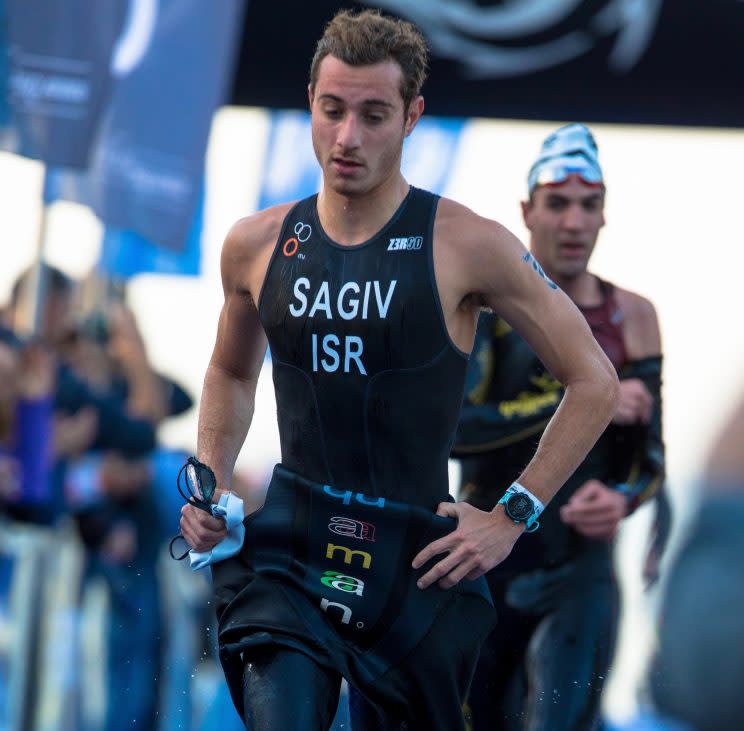
In the mountains above Arava
As I throw on a couple of layers up top, and remain in the wet shorts, I know I’m now heading into the longest part of the race, by far. And unlike the swim, where it was obvious where we were going, the cycle course is a complete mystery to me. All I know is that we’ll be leaving the hotel strip, heading past the arena-sized skating rink / shopping mall – a kitschy oddity that’s surely wonderful in the summer – to begin our ascent into the suburbs.
Eilat being tiny, the houses peter out very quickly, leaving us only with the climbing part, which is unrelenting for some 25kms, across seemingly endless switchbacks. As we grind steadily higher, and the spectacular Arava Valley widens out below us, I feel momentarily sorry for my fellow racers who heeded all of the pre-race warnings and bundled up in tights, gloves, jacket and a hat under their helmets. Unlike me, who didn’t bring any such gear to begin with, they’re drenched in sweat, constantly reaching for their water bottles as they slowly propel themselves up the mountain.
This is what they call cold??? I thought Israelis were supposed to be tough. And no sooner does a sense of well-placed Canadian hubris swell up, do we finally crest the mountain and an icy blast of wind pummels us. Now our 60km out and back begins, and around every corner is another “Caution Dangerous Crosswinds” sign.

Here too is the border with Egypt, marked by a massive steel and barbed wire barrier.
The fence was completed in 2013 and is meant to prevent illegal migration from Africa, as well as the smuggling of drugs and cigarettes across the border. It looks impossible to breach, particularly given the signs warning of electrocution. Nevertheless this morning it’s monitored at regular intervals by Israeli troops on patrol in the hills beside us. They’re bundled up in thick green parkas, which makes sense as it’s now a frigid 4 °C up here.
While it’s far too windswept to fully enjoy it, there is something wondrous about cycling along this stretch of the Sinai. Under leaden skies this morning, it’s like a lunar landscape – rolling, arid and inhospitable, yet starkly beautiful.
However, I’m not even remotely sorry to see the final transition station emerge in the distance, signaling the end of the bike course. Someday I may come back and soak up the dunes in their full glory, but next time it will be in the summer, ideally in a car. For now, I just want to get off this bike and begin the long descent to the finish.
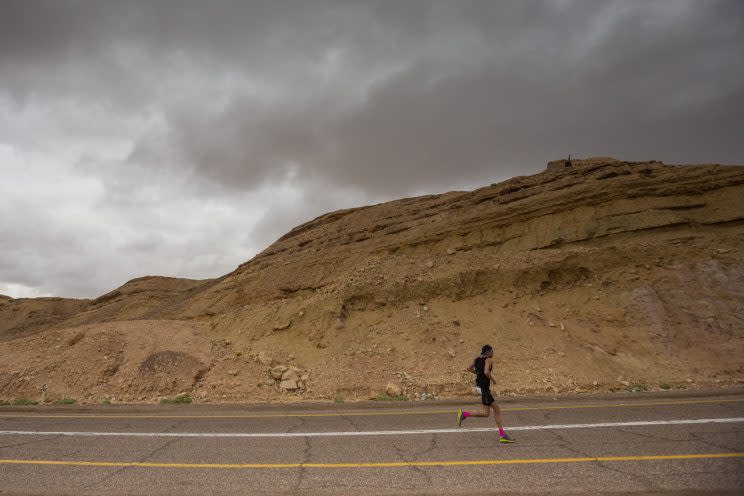
Sin city without the sin
Switching from cycling to running, especially while navigating down a series of steep inclines takes some adjusting, yet this section comes as an immeasurable relief. That’s partly because gravity is at last on our side, but also because with each step out of the mountains, the temperature rises. And not only that, the view is breathtaking. After nearly four hours of undulating desert plateau, the Arava Valley suddenly unfolds in front of us, showing glimpses of the Negev to the north, the Jordanian mountains like a wall to the east, leading to Saudi Arabia.
As the view unspools, the sun begins to poke out of the clouds, bathing everything around us in a golden glow. Including, far to the south, the towering hotels of Eilat, clustered together in tight circle, like a tiny Las Vegas coiled in on itself.
In many respects, the city echoes many elements of that other desert retreat save for one key feature, there’s no gambling here. For that, you have to go up the street and around the corner to Egypt, where a miniature version awaits in Taba. However, hints of Vegas still loom large, from the high-end emporiums attached to the hotels, to the dance bars, evening shows, chi chi restaurants and massive buffet meals.
There are also the business cards scattered on the sidewalks, offering escort services a quick phone call away.
To be fair Eilat seems spared the stretch limousines and bachelor party debauchery that dominate so much of Vegas. Far more common here are young Orthodox families with strollers and swarms of small kids. (In the hotels, a special Sabbath elevator stops at every floor so that they can reach their room without pressing a button and ‘creating’ work).

The final stretch
Right now, I’m still more than a few miles from all of that. All I’m thinking about is how glad I am to be running downhill rather than up. That is until we reach the suburbs and begin to level off. Now I just want to be finished.
And we’re almost there. The route has taken us towards the hotel strip, but as we approach, instead of turning in, we continue south, towards Taba for another 5km before turning back. Running along the coast we come to the grittier side of this port town, the loading docks, warehouses and refineries.
Views grimy or glorious no longer matter. We’re all well past the point of sight seeing. The only things we’re looking for at this point are the kilometre signs slowly counting up – 18, 19, 20 – marking off the end of the 21km run.
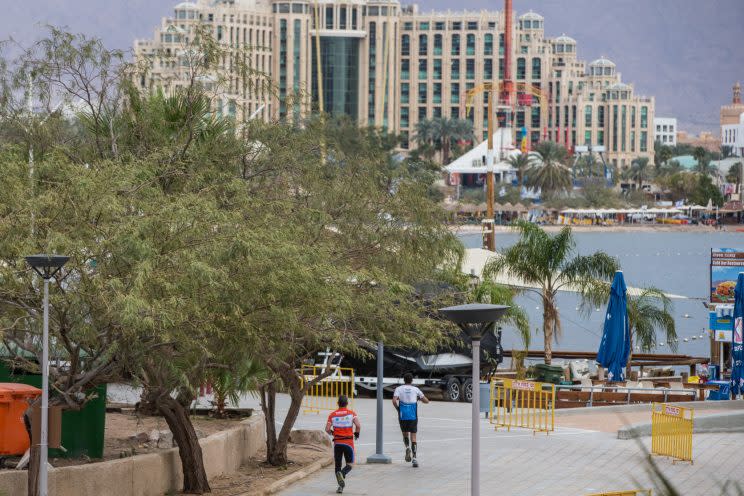
Finally, we do one last loop of the hotels, passing the airport as we go. It’s essentially a single landing strip, a vestige of the early 1960s, and will be gone within the year. In its place will be a much bigger terminal 20km north. The initial vision was for the new airport to serve both Eilat and Aqaba, on the Jordanian side of the border, to be jointly operated by the two countries. But that plan came and went, and Eilat will go it alone.
If an unyielding spirit in the face of adversity is valued here (and it is) then it’s clear why the Israman Garmin is such a good fit for this town, if the not the country writ large. Extending from the sea to the mountains, with no small amount of sun, desert, wind and fearsome fences though in, the race is unapologetically tough, yet undeniably appealing.
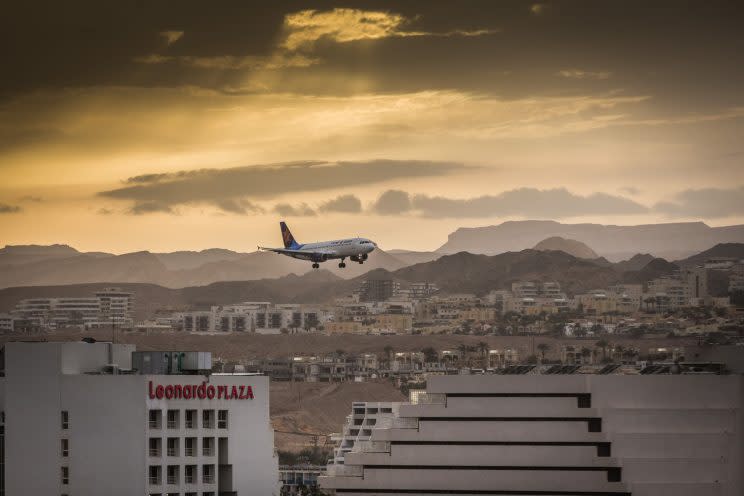
How to get there:
Once you’re in Israel, getting to Eilat is the easy part. There are 55-minute flights almost every hour from Tel Aviv. The price is approximately C$200-C$250 return, depending on the time and day of week. Alternatively you can drive from Jerusalem or Tel Aviv. The journey takes approximately four hours. The ideal route for first-time visitors to Israel is to drive it as a loop, either traveling down through the Negev and the spectacular Ramon Crater, and coming back via the Dead Sea, Masada and the Judean mountains, or vice versa.
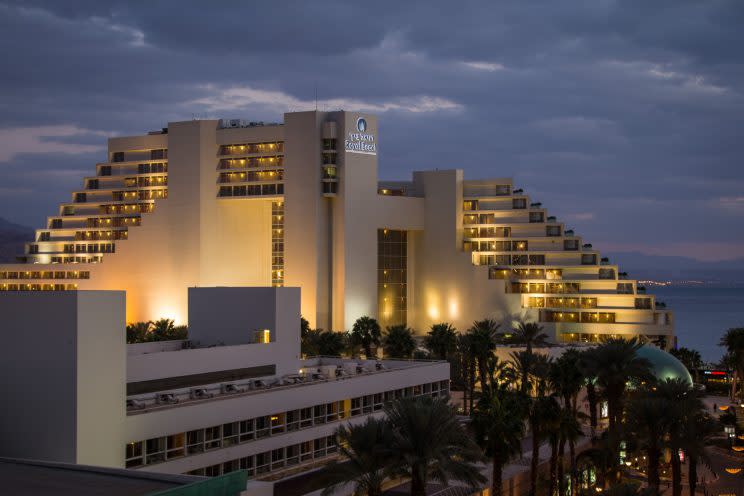
Where to stay:
As mentioned, Eilat is an extremely popular weekend destination, with a range of hotels catering to every price point. That said, the main strip is the preserve of the four-star spa-and-pool resorts that start at C$250-per-night and climb steadily higher as you move closer to the beach. Most offer breakfast buffets, and as anyone who has been to Israel knows there is no more sumptuous way to start the day.
What to see:
Aside from the sun, the main attractions here are the beaches. A little chilly in the winter, the water is still inviting enough. And while you won’t see much marine life at the most popular beaches, the 1km-long coral reef is a short drive away and is ideal for snorkeling or scuba diving. Next door is the Underwater Observatory Marine Park where you can see sharks, stingrays, piranhas and electric eels swimming about in seemingly in perfect harmony.
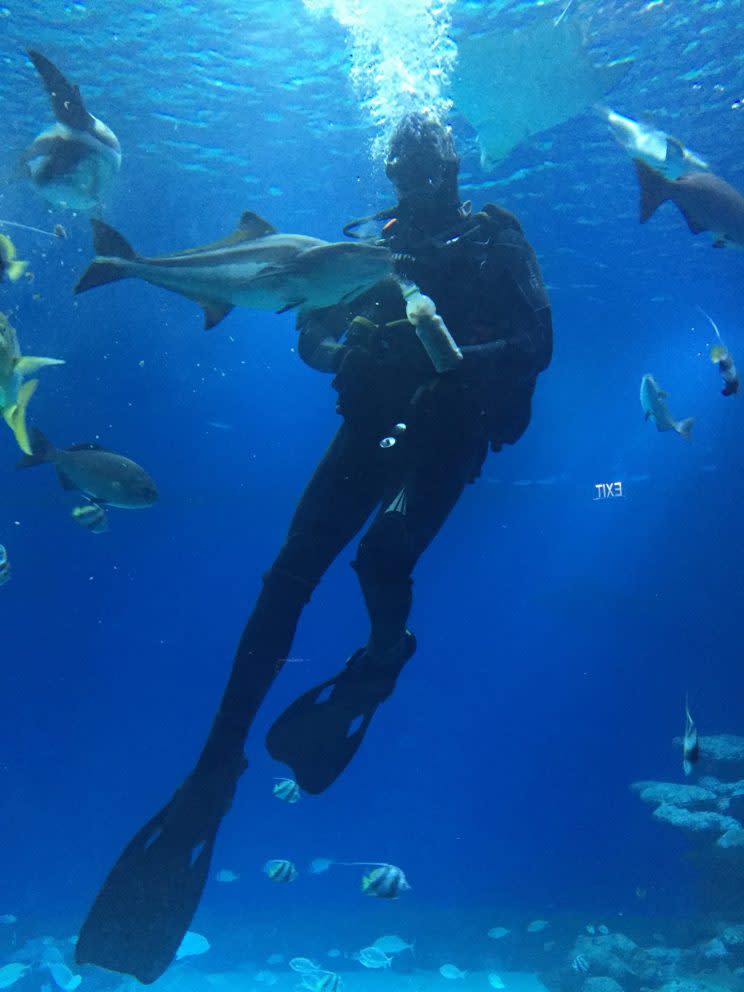

 Yahoo Finance
Yahoo Finance 
